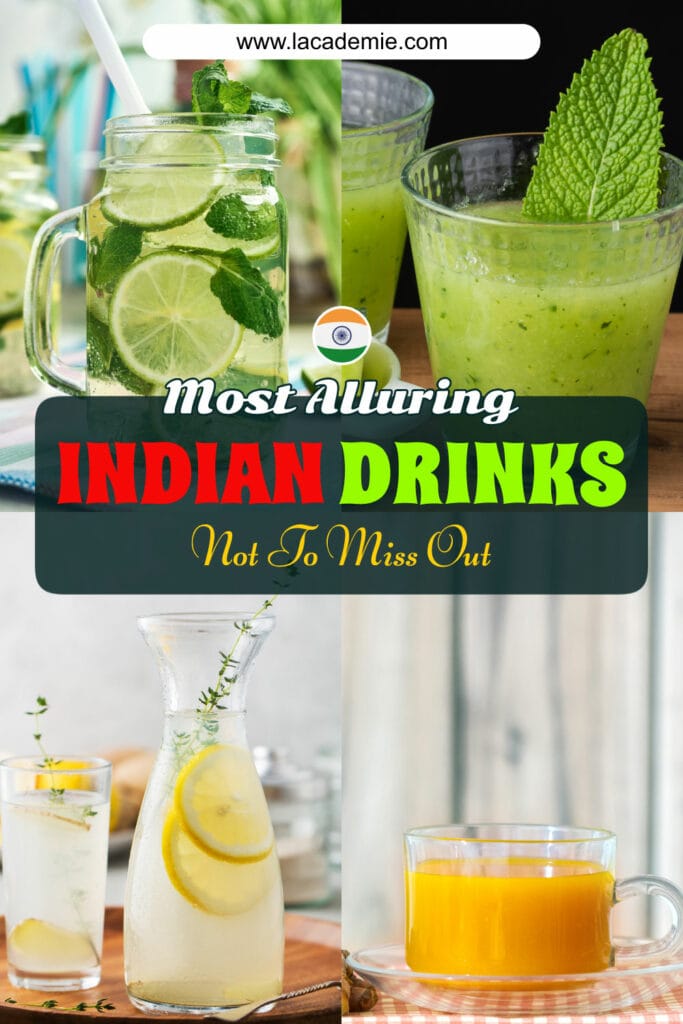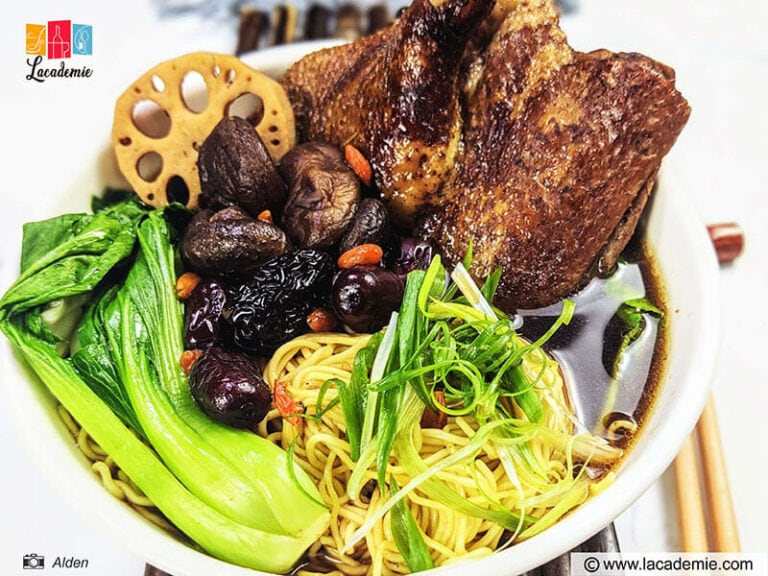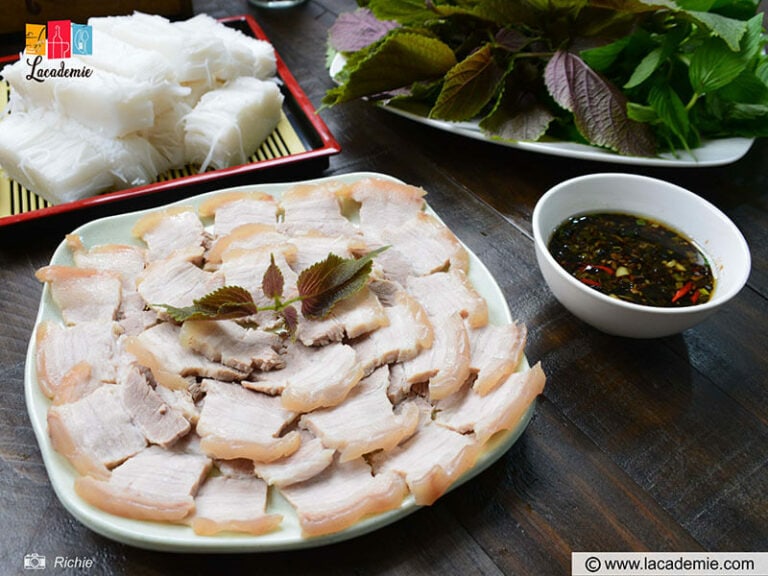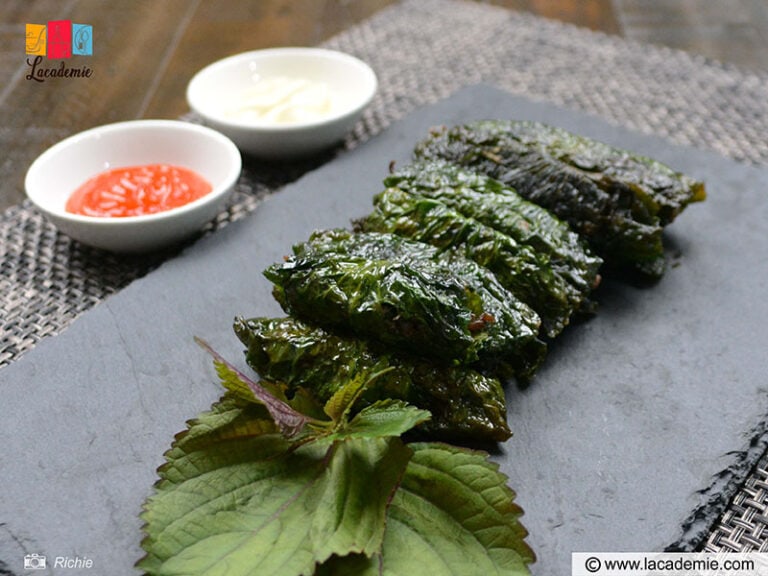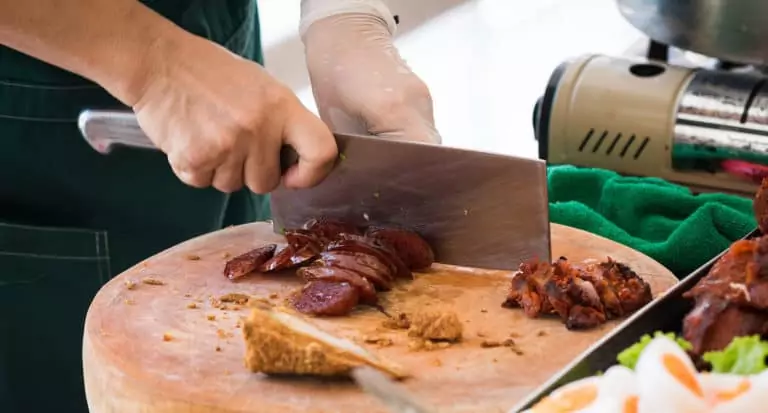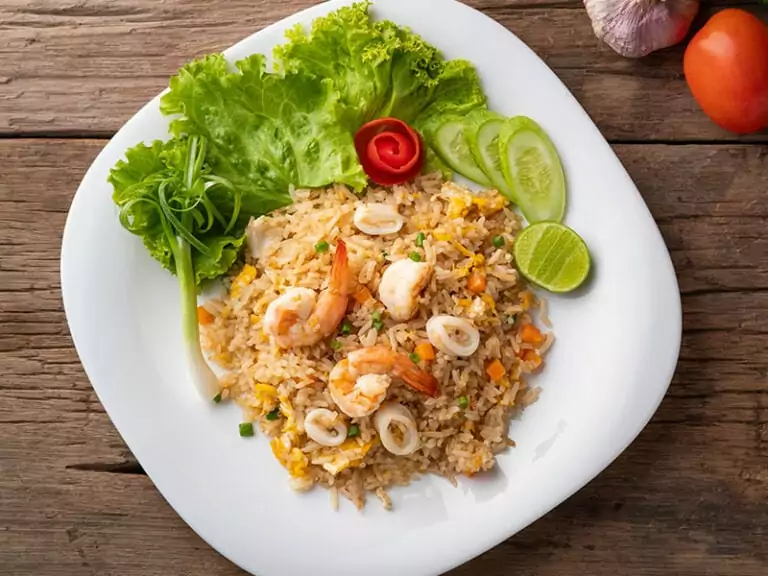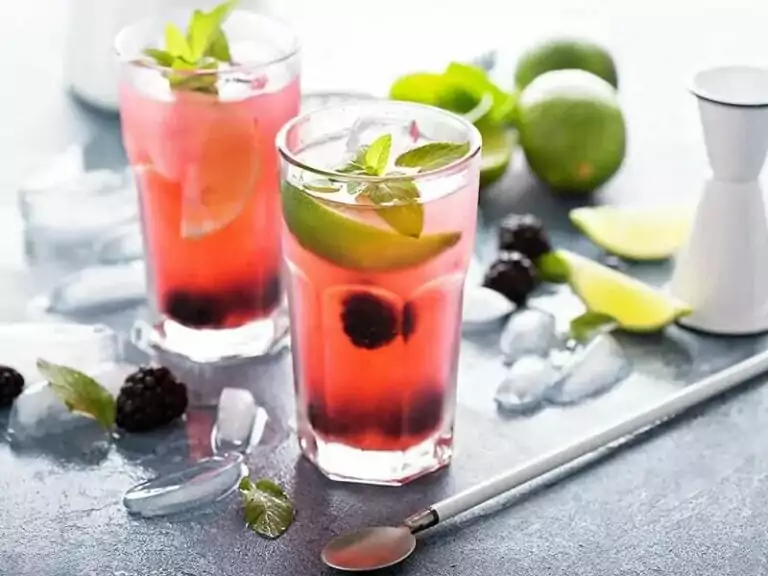Once mentioning Indian drinks, what immediately comes to your mind? Indian beverages are not all about Masala Chai or teas; there are many more things you can discover from this magnificent gastronomy.
Because of this country’s religious diet, there might be some restrictions on the drink they can include in their daily life. However, this fact doesn’t make your Indian-originated drinks list dull. In fact, I will suggest various fascinating options that will amaze you.
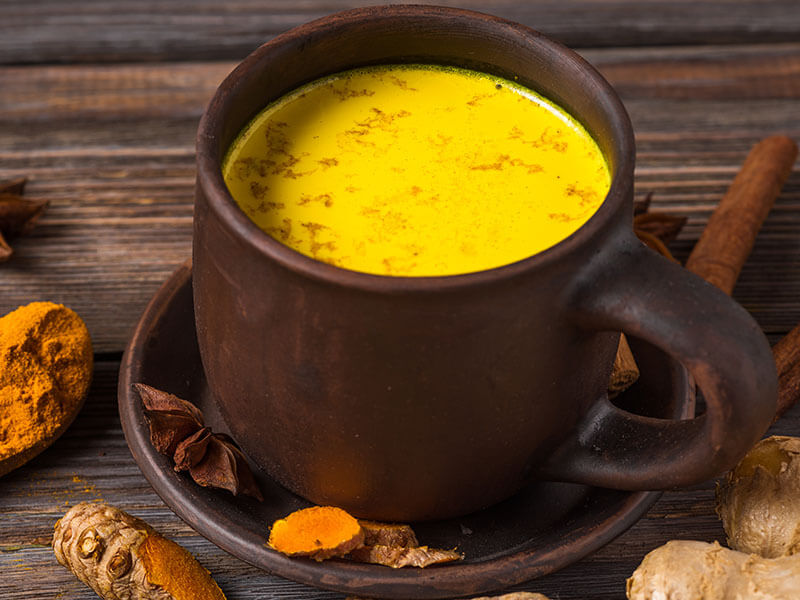
Short Facts About Drinking Culture in India
Before digging deeper into the delectable beverages you can try in India, let’s first talk about Indian drinking culture. Many people assume that alcoholic beverages are forbidden in India due to religious reasons. However, this rule doesn’t apply to all ages and every individual.
The truth is, only females and underage males are forbidden to consume these kinds of drinks, and these rules are now things from the past.
Nowadays, thanks to globalization and cultural change/adaptation, everyone can consume alcoholic drinks when they are above 18 or 21 in some parts of the country.
Because of that, don’t be surprised if you can find some luscious alcoholic drinks in today’s article. No more beating around the bush; scroll down to check my recommendations below!
Indian Non-Alcoholic Drinks
I’ve briefly introduced Indian drinking culture, and now I will directly offer you several beverages that you should give a go whenever you have a chance. I promise that the below drink ideas won’t disappoint you.
1. Masala Chai (Spiced Milk Tea)
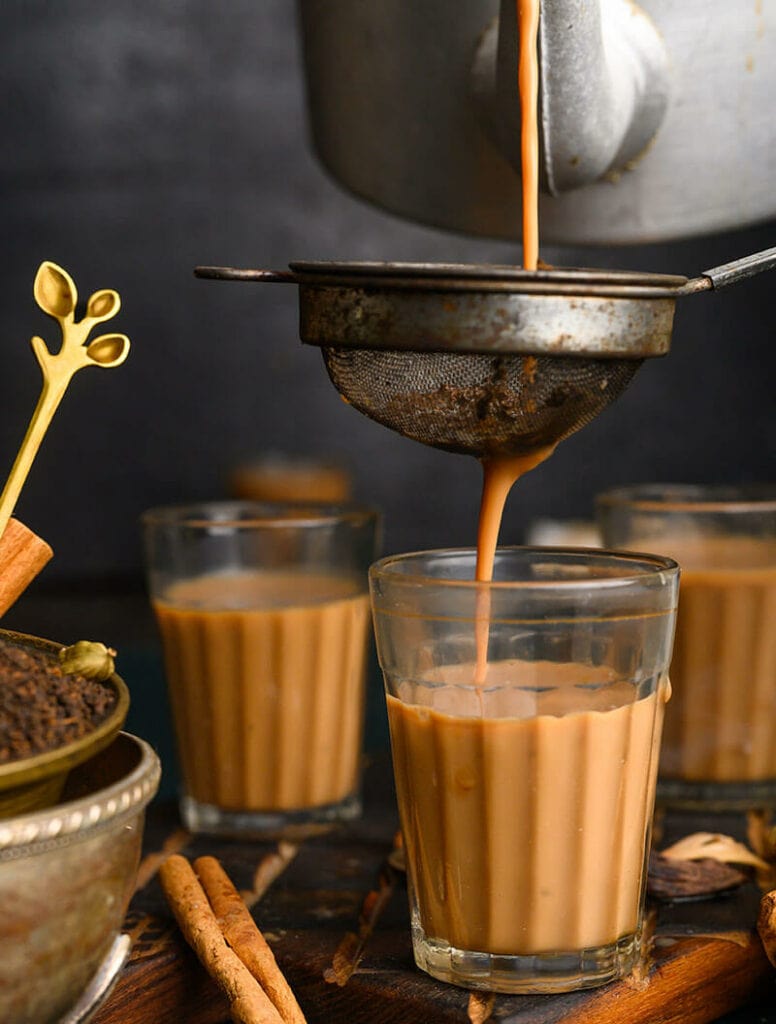
This unique aromatic yet milky tea is now a breakfast staple in India, and no one can deny that fact. However, do you know about this complimentary drink’s origin?
Black tea had already been a tea yielded in India thousands of years ago and also a favorite drink for the royal family. But, during the British colonial times, it became more and more famous that Indians started consuming and cooking with all sorts of ingredients to create Masala Chai.
Indian locals usually include milk and Masala (meaning “spice mixture” in their language) in the original British milk tea recipe and make it more “Indian”. Note that each region or Indian vendor may have their personal choices of spices, leading to a diverse flavor in the milk-based tea.
The typical spices included in this tea are cardamom, nutmeg, cinnamon, and other aromatic things. It might sound weird, but the flavor can range from fragrant cinnamon to spicy ginger. Alternatively, you may enjoy Irani Chair or Cutting Chai in place of this herbal drink of Masala Chai.
Where to find: At the street vendors/stores and restaurants across India.
Have 4 minutes to spare? Let’s make some Masala Chai with this instruction!
2. Masala Chaas (Spiced Buttermilk)
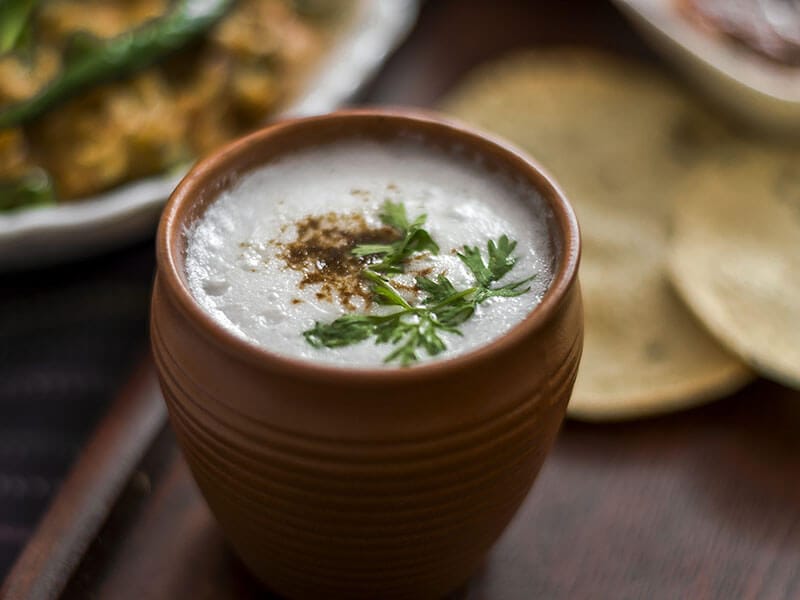
Another use of Masala spices mixed in an Indian beverage is this Masala Chaas or Indian spiced buttermilk, considered to be one of the perfect energy drinks in the morning. The spicy note from the signature spices does its work well in highlighting Masala Chaas, and the diluted yogurt helps create an outstanding balance.
Masala Chaas is a popular, affordable, and easy-to-preserve drink in the Indian subcontinent. In some ways, Masala Chaas is relatively similar to Lassi, another signature yogurt-based drink of Indian cuisine.
Furthermore, this toothsome drink tastes phenomenal when chilled, making it an ideal summertime treat for everyone.
Where to find: At the street vendors, online stores, and restaurants across India.
3. Nimbu Pani/Shikanji (Lemonade/Limeade)
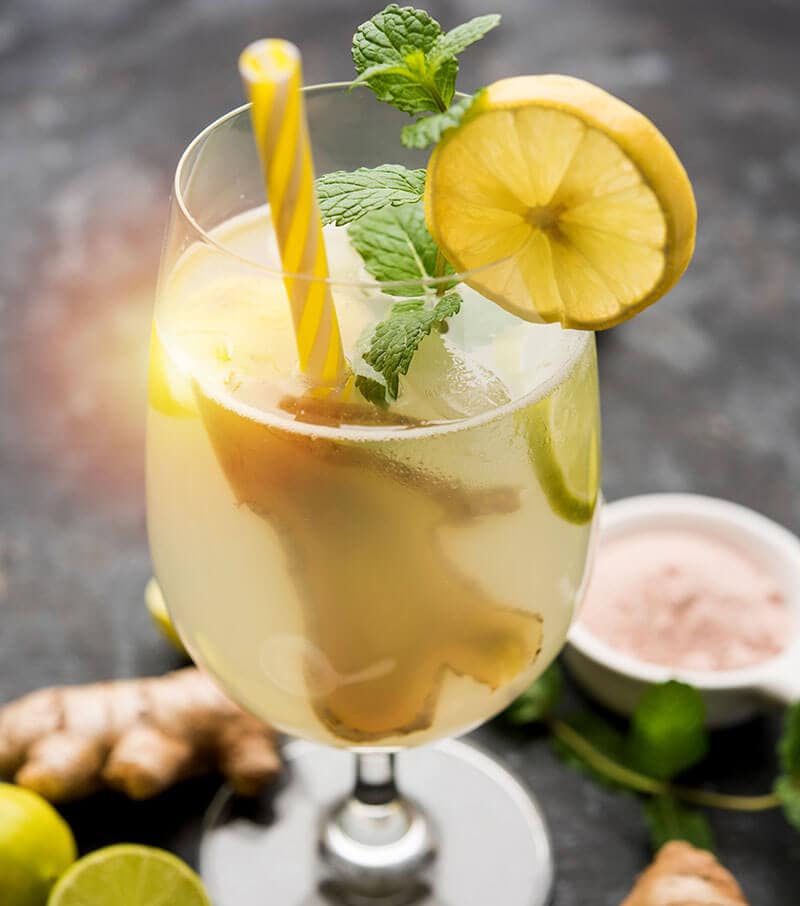
Have you ever tried spiced lemonade/limeade? To be honest, I was really amazed the first time trying this Northern Indian drink as it had a gorgeous hint of saltiness and earthiness besides the typical tartness of those little Indian lemons.
Those prominent additional notes from cumin, Chaat Masala, black pepper, and salt create a refreshing drink in the summer. Furthermore, those Indian’s signature spices create many health drinks, making them suitable for all ages. Commonly, locals will dilute the spice and lemonade mixture using soft drinks like club soda.
You can get a cup of Nimbu Pani (meaning “lemon water”) at the school front or at various street vendors as a treat on hot summer days in India. Who can resist a cup of refreshing drink?
Where to find: At the street vendors, cafes, and juice stores in India.
This is the best video showing how to make Nimbu Pani in an Indian way!
4. Aam Panna/Aam Jhora (Mango Mojito)
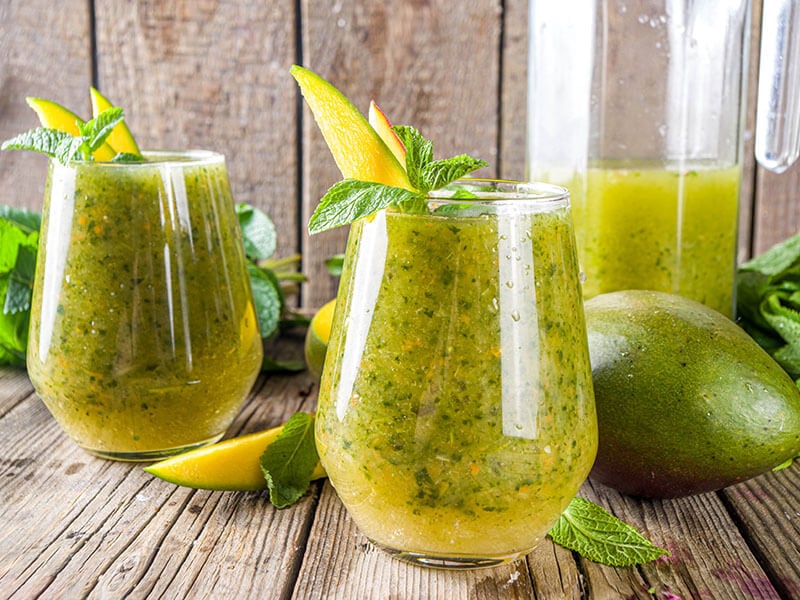
Most famous in the Northern part of India, this Indian-associate recipe is a summer-cooling beverage that everyone should try once. The word “Aam” means “mango” in the Hindi language, and it does tell a bit about the main ingredient for this drink.
Aam Panna typically requires raw/unripe mango, the main reason for its unique light green (or yellow) color. Thanks to the use of other spices like cumin or cardamom, this luscious beverage is an excellent source of iron and sodium chloride.
It also benefits your digestive system and helps boost the resistance against anemia, tuberculosis, etc., so there is no reason not to give this healthy, tonic treat a go. Locals usually sweeten the drink with jaggery or sugar cane with a bit of mint and salt for extra flavor.
Where to find: At the street vendors, cafes, and restaurants in India (mainly in North India).
5. Kheera Pudina Lassi (Cucumber Mint Yogurt-Based Drink)
If you ask me whether this Lassi drink is vegan-friendly or not? No, Lassi is not vegan-friendly. Although this Lassi has no meat or other meat-based products, it calls for yogurt as its base. Therefore, it is better to consider this drink an Indian vegetarian-friendly recipe instead.
Coming from the Punjab region of India, the traditional Lassi now contains lovely twists with a refreshing minty/refreshing taste from both mint leaves and fresh cucumber. Traditionally, local people serve Lassi (either salted or sweetened) with a dollop of ice cream.
Having ice cream alongside Lassi is surely mind-blowing as it will neutralize the light zing of the green chili. You can have this Lassi as a post or pre-exercise drink or as a light filler treat between meals. It serves as one of the sports drinks for you to work out in a short time.
Where to find: At the street vendors, juice stores, and cafes across India.
6. Aam Lassi (Mango-Flavored Yogurt-Based Drink)
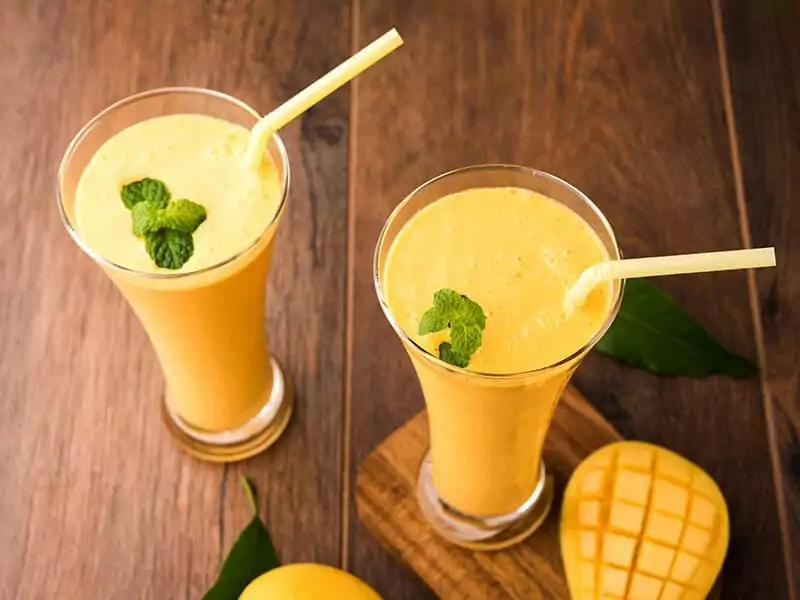
It’s Lassi, but it calls for fruit this time. There is nothing as perfect as a cup of Mango Lassi, whether the weather is hot or cold. Trust me, the combination of tropical sweetness (from mango) and light sourness (from the yogurt-based drink) literally makes sense every time.
The consistency of Aam Lassi is pretty thick, and its taste includes everything you can imagine about ripe mango. Its sweet and light tart flavors remind you of a relaxing summer beach.
However, the woody and citrusy notes from a dash of cinnamon are indeed the true stars of Mango Lassi. You can consider having a cup of Aam Lassi as a pleasant and soothing Indian-style dessert after a savory meal. I guarantee that it will be so satisfying!
Where to find: At the Indian tea/juice stores or sweet shops in India.
7. Thandai (Spiced Holi Drink)
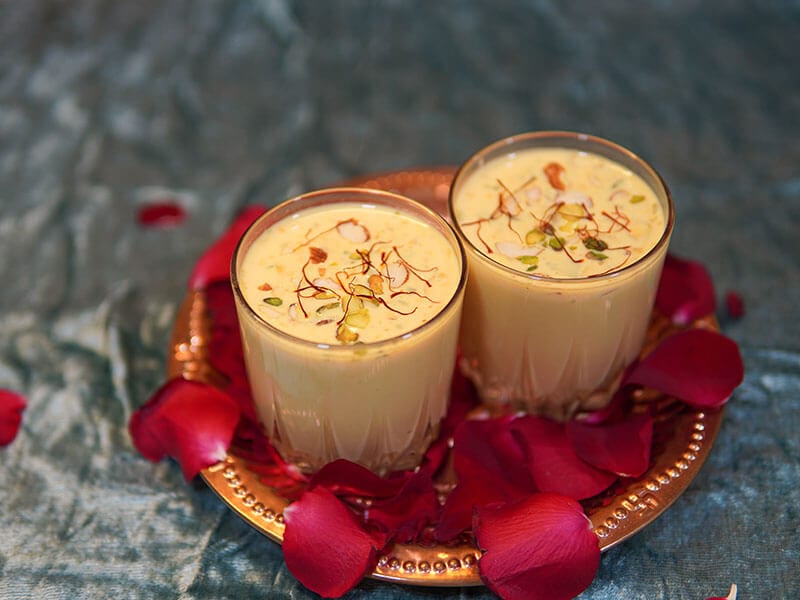
Holi, or Festival of Spring, along with Maha Shivaratri, is a traditional religious occasion of Indians, where people celebrate new life, love, and new season. And Thandai, which means “something cold/refreshing” in Hindi, is a great beverage to try during this time of the year.
North Indian people love this drink so much that they believe their traditional celebration won’t be complete without a cup of Thandai. Besides the regular ingredients like rose water, milk, saffron, or some spices, the star of Thandai is Bhang (Cannabis/marijuana) for an adult version of the drink.
Local people will finely crush the plant’s flowers/leaves into powder before adding it to the drink. The special ingredient, considered an addictive drug, has a unique compound that affects your brain and changes your mood.
Because of that, if you try to create some Thandai at home, I suggest you omit this ingredient as it is pretty risky for a beginner. Making Rose, Badaam Kesar (with almonds and saffrons), or Mango Thandai might be the better option the first time trying this cold beverage.
Where to find: At grocery stores, beverages distributors, dairy or juice stalls in India.
8. Paneer Soda (Rose Water Soda)
Don’t misunderstand this “Paneer” with the term meaning “cottage cheese “, which is typically used for Indian-inspired curries. The term “Paneer,” in this case, means “rose water” (Tamil language), and it contributes a lovely fragrance to this soda/sparkling fizz.
Having its origin in South India, Paneer Soda is famous around the country. The idea is to create mocktails using available ingredients that anyone can get in India. Sometimes, you may find Paneer with different colors ranging from blue to vibrant red from the used syrup.
You only need to make a sugar syrup mixture first, wait for it until cool, and add some rose essence in. The sellers can then put the rose-sugar syrup in the fridge and save it for days. As it is pretty effortless, finding it at the street vendors is not a daunting task.
Where to find: At grocery stores or soft drink shops in India, especially in Tamil Nadu.
9. Indian Ginger Ale (Ginger and Lemon Mocktail)
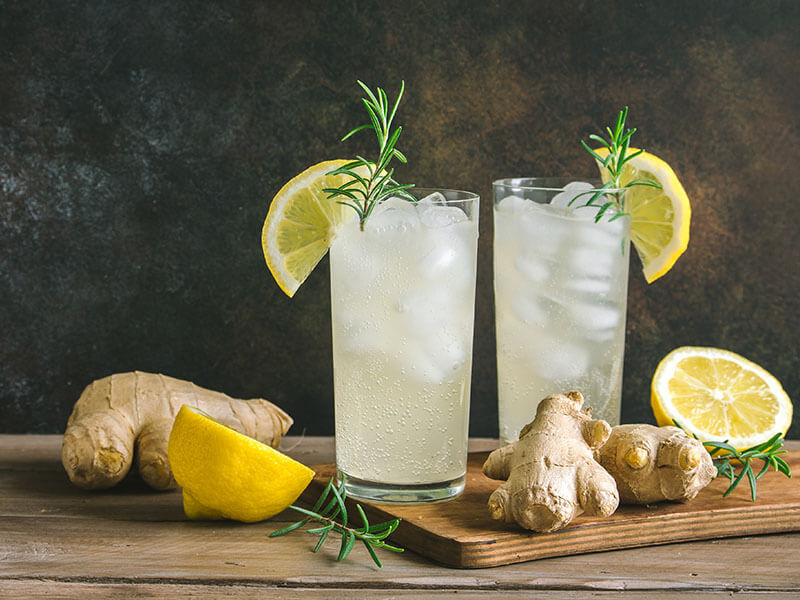
During the summer, Ginger Ale is an excellent thirst quencher that offers a toothsome taste combination of ginger and lime juice. It is often served at family reunions or special occasions, such as the Navratri festival (a Hindu festival spanning 9 to 10 days) or a simple party event.
The main idea to make this delight is to mix ginger, lemon, and lemongrass juice (sometimes) into a cup and stir the mixture well with soda and sugar syrup.
The tip to making this Mocktail even better is to heat the lemongrass juice, which is optional, on high heat for a few minutes before assembling the drink. Try it and thank me later.
Where to find: At grocery stores, soft-drink shops, or supermarkets in India.
10. Panakam/Panagam (South Indian Summer Drink)
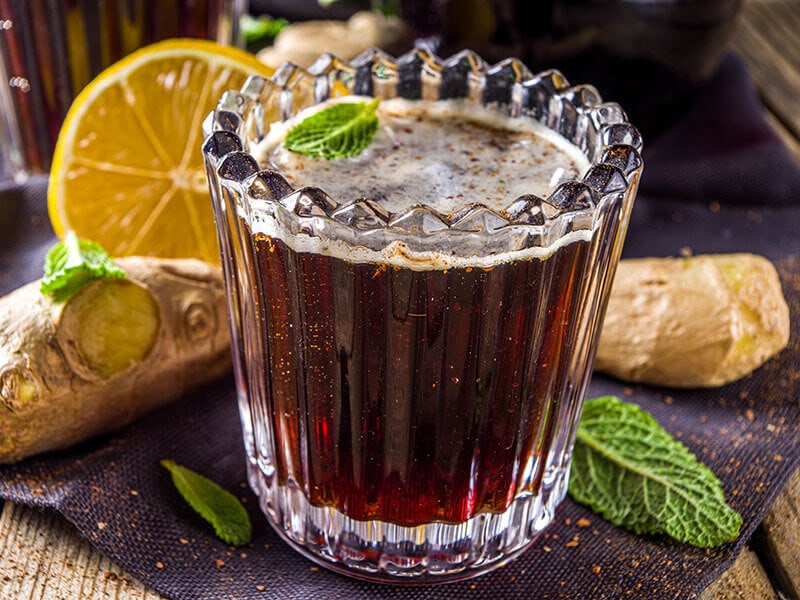
As its English name tells, Panakam/Panagam is an authentic South Indian delight. Local people love having this for Ram Navami, Lord Rama’s birthday festival, or feature at wedding ceremonies.
Traditionally, they will serve the drink to their God first at Hindu temples before sharing it with others as prasad (food or beverages offered to a god by worshippers). Surprisingly, Panakam can help with indigestion and hydrate your body.
Besides the common ingredients such as jaggery, ginger/cardamom powder, etc., tulsi leaves (holy basil leaves) are a particular component for festive versions of Panakam. On hot days, you can ask the sellers to put some ice cubes into your drink and make it even cooler.
Where to find: At traditional drinks vendors in India. You can also make it at home.
11. Haldi Doodh (Turmeric Latte/Golden Milk)
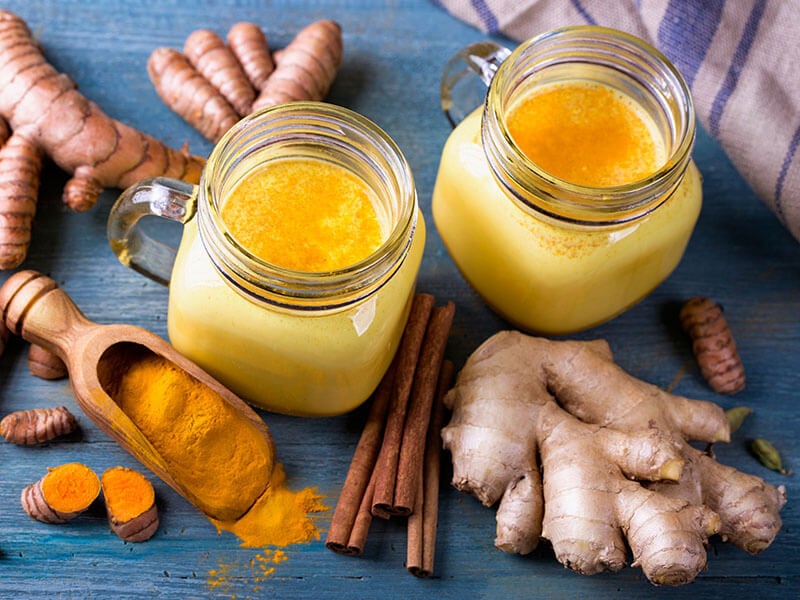
Turmeric is a superfood loaded with beneficial curcumin, which helps control your metabolic syndrome, arthritis, or inflammatory conditions. The idea of combining turmeric powder with milk to form a palatable drink has existed in India for hundreds of years.
Since then, local people have consumed this Latte as an Ayurvedic medical remedy, and it is even more prevalent worldwide now. Turmeric milk has a bright yellow color and usually includes almond milk (or cow milk) mixed with turmeric powder.
Other spices such as black peppers or ginger are also essential to provide an intense/warm taste on the palate when enjoying.
Where to find: At various dairy stores around India.
12. Filter Kaapi/Madras Coffee (Filtered Coffee)
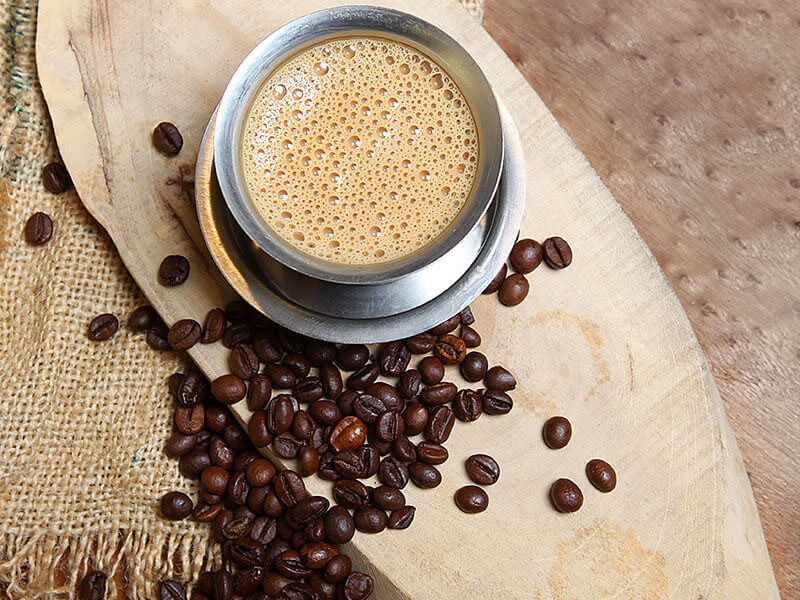
Coffee is the most famous energized drink globally, and Indian people also developed their own variation of this caffein-loaded drink. The recipe of Filter Kaapi initially appeared in the Karnataka region of India at the beginning of the 17th century.
Furthermore, the name “Kaapi” of this drink is also a derivation from the English word “coffee,” and it also has its roots in South India, a rich and distinct cuisine of Indians. However, making this kind of coffee is relatively different from the western-style.
A special, stainless filter consisting of two smaller chambers is their secret to receiving such a delightful cup of Coffee. To have a frothy cup of Filter Kaapi, local sellers will continuously pour the mixture of Coffee and milk into the cup and out for a couple of minutes.
Where to find: At various coffee stores throughout India.
13. Jigarthanda (Cold Heart Drink)
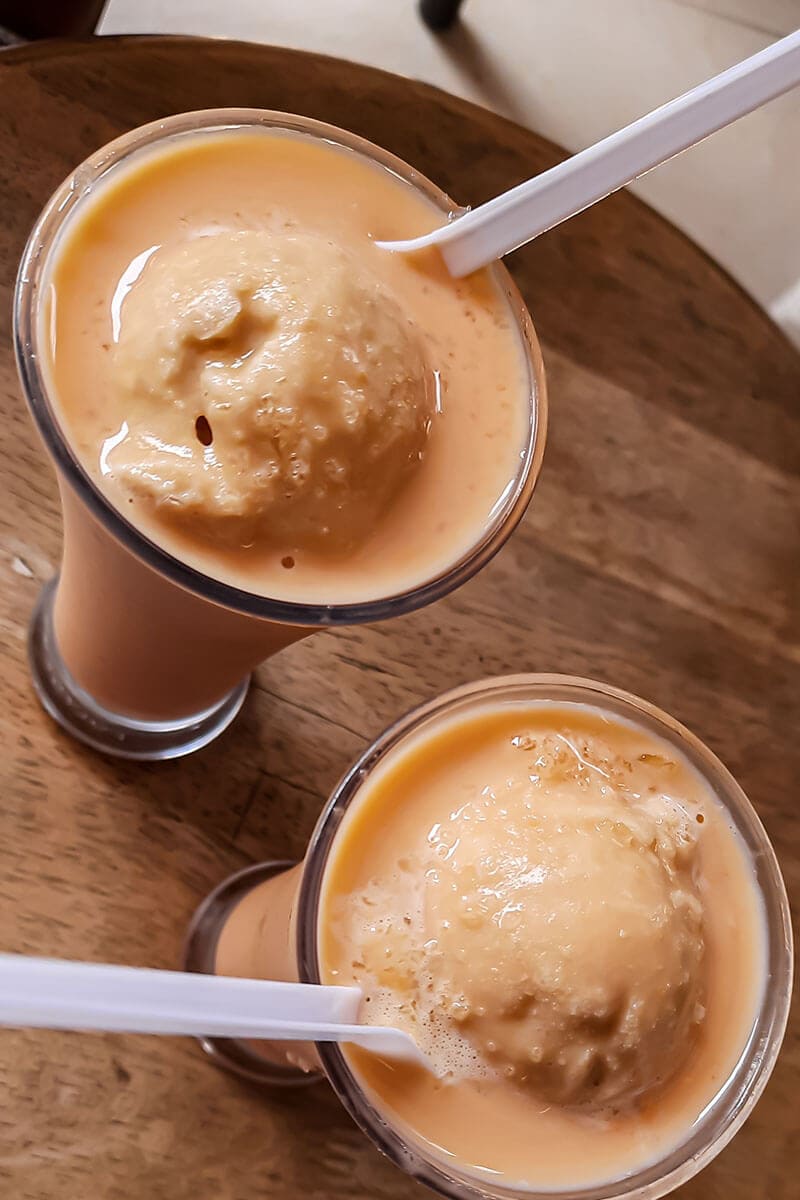
Jigarthanda is a delectable cold beverage, originating from the bustling city of Madurai in Tamil Nadu, South India. The name, Jigarthanda, translates to “cold heart” in Hindi, which aptly describes the refreshing nature of this popular summer drink.
On hot days, street vendors can be found serving this delightful concoction as a respite from the sweltering heat. The key ingredients that make up this distinctive beverage include milk, sarsaparilla root syrup, ice cream, and almond gum.
These components come together to create a unique slushy drink bearing a brow color. The sarsaparilla root syrup lends an earthy, herbal undertone to the drink, while the almond gum provides a sweetness. The addition of ice cream introduces a velvety richness to Jigarthanda.
Where to find: Street vendors, cafe stores, and stalls across India.
14. Ragi Malt (Ragi Flour Porridge)
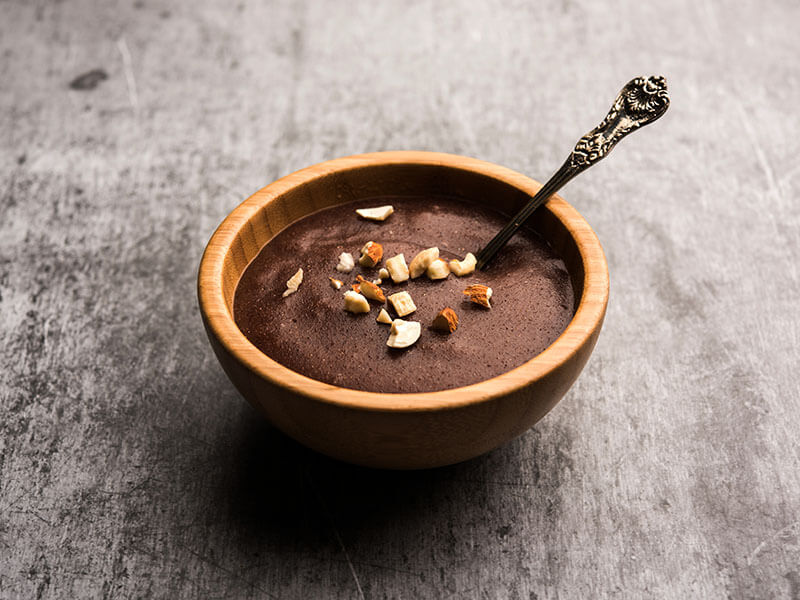
Ragi Malt is a dark-brown nutritious porridge that has become a favorite among children in India. Made from Ragi flour derived from finger millet, this wholesome dish can be enjoyed both hot and cold, making it a versatile meal option for any time of the day. Ragi Malt is typically offered in two varieties, either sweet or savory.
The savory version of Ragi Malt features a refreshing combination of buttermilk and spices mixed with Ragi flour, perfect for a tasty Indian meal in the morning. This blend creates a flavorful and satisfying porridge that can be enjoyed as a light meal or a tasty Indian snack in many local households.
On the other hand, the sweet variety incorporates milk with Ragi flour, sweetened by sugar or jaggery, and is often topped with almonds for added texture.
Indian locals frequently serve viscous Ragi Malt to babies, as it is not only easy to digest but also packed with essential nutrients. Rich in vitamins, minerals, and fiber, Ragi Malt provides an excellent source of nourishment for growing children.
Where to find: At local stores in India for buying Ragi flour.
15. Falooda (Faluda Ice Cream)
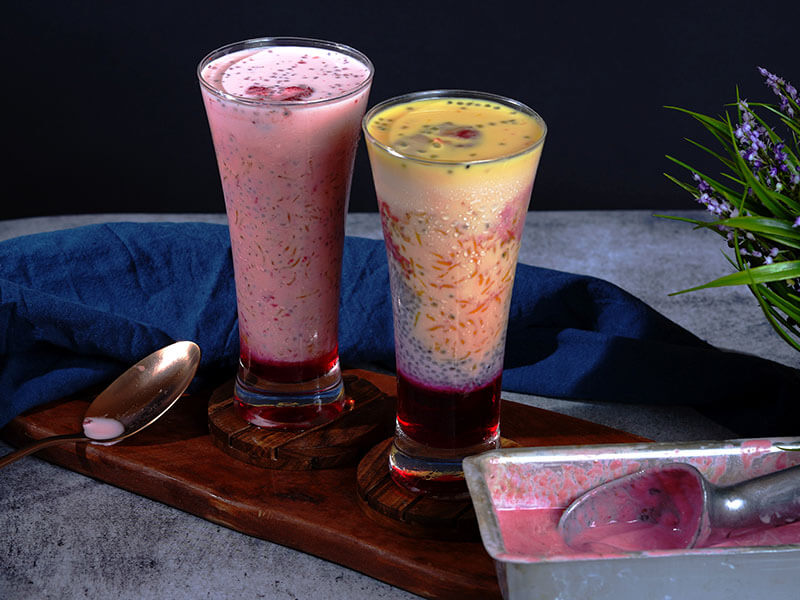
Falooda is a delightful cold Indian drink with a rich history inspired by the flavors of Persian cuisine. The modern version of Falooda can be traced back to the Mughal Empire, which spanned between the 16th and 19th centuries.
Over time, this refreshing beverage was embraced by the Hyderabad Deccan and Carnatic regions of India, each adding their unique twists to the original recipe. Today, Falooda is not only enjoyed as a drink but also served as a dessert.
At its core, Falooda consists of a delicate mixture of rose syrup, vermicelli, and basil seeds, all soaked in milk. The noodles used in this drink are commonly made from cornstarch, arrowroot, or wheat, lending a smooth texture.
Falooda has become a popular choice for weddings and celebratory events across India, where it is often served to guests. For added flavor, many popular variations of Falooda include ice cream or jelly. These enhancements not only elevate the visual appeal of the drink but also create a more satisfying experience.
Where to find: At local coffee shops and vendors in India.
16. Jal-jeera (Tangy Indian Summer Drink)
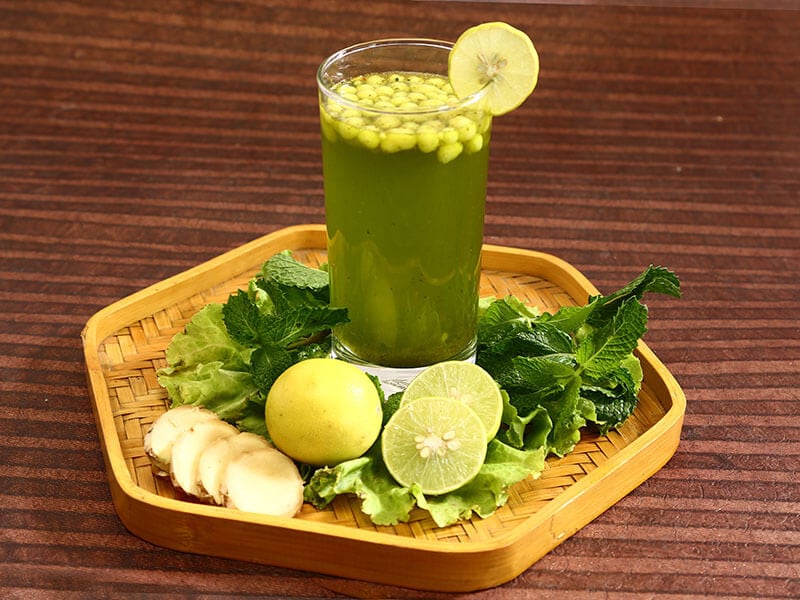
Jal-jeera is a rejuvenating Indian drink renowned in the northern part of the country for its distinctive vibrant green color. The name “Jal-jeera” stems from the Hindi words “Jal,” meaning “water,” and “jeera,” which refers to cumin.
Traditionally, the base of this beverage is either lemonade or another tangy-flavored liquid, making it a popular choice during the summer months. The key to its unique flavor is the Jal-jeera powder mix, which typically contains a blend of mint and cumin.
Often served as an appetizer, Jal-jeera is believed to have originated along the banks of the Ganges River. In the past, the Jal-jeera powder was meticulously ground using stone slabs and then stored in clay pots to preserve its freshness and flavor.
Where to find: At local vendors and food stalls in India.
Indian Alcoholic Drinks
Here are a few mixed drinks options in the form of refreshing Indian cocktails or original creations of Indian cuisine you can make at home. Bring a fresh approach to your drink menu with these alcoholic options.
Instead of worldwide options like brandy, vodka, or champagne, Indian locals prefer creating their own brand of alcohol using available ingredients.
17. Feni (Indian Cashew Liquor)
Alcoholic
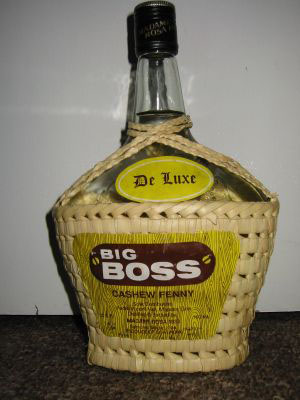
Feni is a distinctive liquor native to the state of Goa, India, where it is highly regarded for its unique flavor and heritage. Locals use either coconut or cashew as the spirit’s base before undergoing a meticulous distillation process to achieve its characteristic transparent appearance and aromatic fragrance.
With an alcohol content of around 45%, Feni is a potent and celebrated beverage in the region. Cashew Feni, one of the two popular variants, is crafted using ripened cashew fruits that have fallen to the ground. The fruits are then pressed to extract their juice, often through a traditional method of stomping.
To create the desired flavor profile and potency, the juice goes through three distillation processes before resulting in the final product. Feni can be enjoyed in various ways, including as a component in cocktails or mixed with fruit juices. For those who prefer a simpler experience, Feni can be sipped neat with the addition of a sweetener.
Where to find: In the Goa state of India, local liquor stores, or distributors around the area.
18. Arrack
Alcoholic
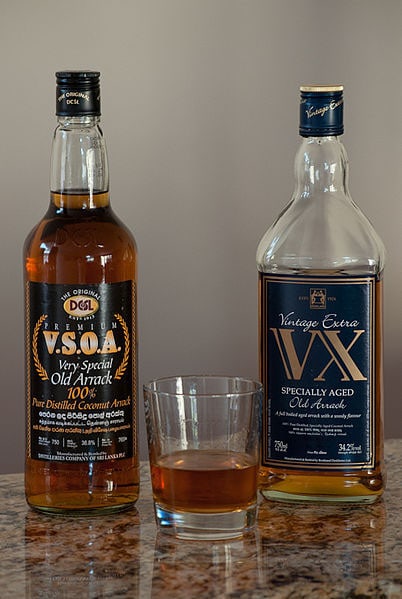
Arrack is a distilled alcohol rooted in India, Sri Lanka, and Southeast Asia. Each country’s Arrack employs various ingredients, with grains, coconut flowers, and sugar cane being the most common. This versatile spirit showcases an alcohol content of around 50%, similar to what you can find in whisky.
There are two prominent styles of Arrack, Batavia Arrack and Ceylon Arrack. Batavia Arrack, which is clear in color, is made from red rice and bears a taste profile similar to dark rum. However, Ceylon Arrack is more refined, with a hint of Cognac and a delicate essence of floral flavor.
In India, Arrack is typically produced using rice as the primary ingredient, resulting in an alcohol content that ranges from 33% to 50%. In some regions of the country, people also distilled Arrack using Toddy, a type of palm alcohol. Like many fine spirits, the flavor of Arrack improves over time when aged, allowing a complex note.
Where to find: Popular across India at liquor stores.
19. Chhaang
Alcoholic
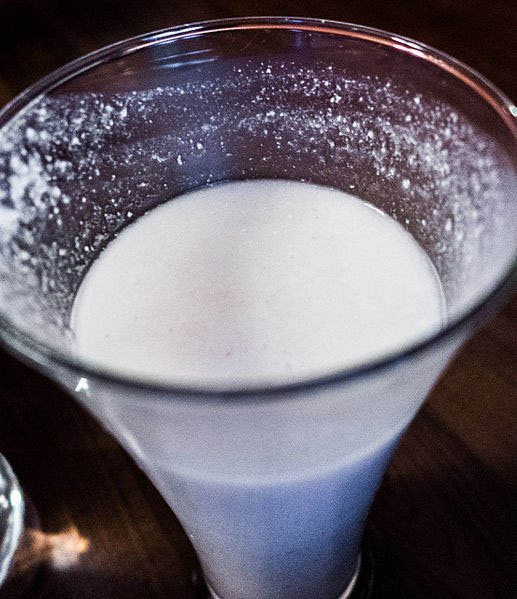
Chhaang, also known as Chhyang, is a popular beverage in the eastern Himalayan region, particularly cherished in Tibet and Nepal, especially in the winter. This traditional drink is characterized by its signature milky white color, although it may appear as a murky yellow hue when commercially produced.
Commonly, Chhaang bears some resemblance to beer, as it is typically made from barley, millet, or rice grains. The preparation of Chhaang involves a unique process of semi-fermentation in a bamboo barrel called a dhungro.
Once fermented, water is added to dilute the mixture before consumption. Chhaang is typically served at room temperature during the summer months, providing a soothing and revitalizing experience.
Where to find: Areas near the east of the Himalayas and local stores.
20. Apong (Rice Beer)
Alcoholic
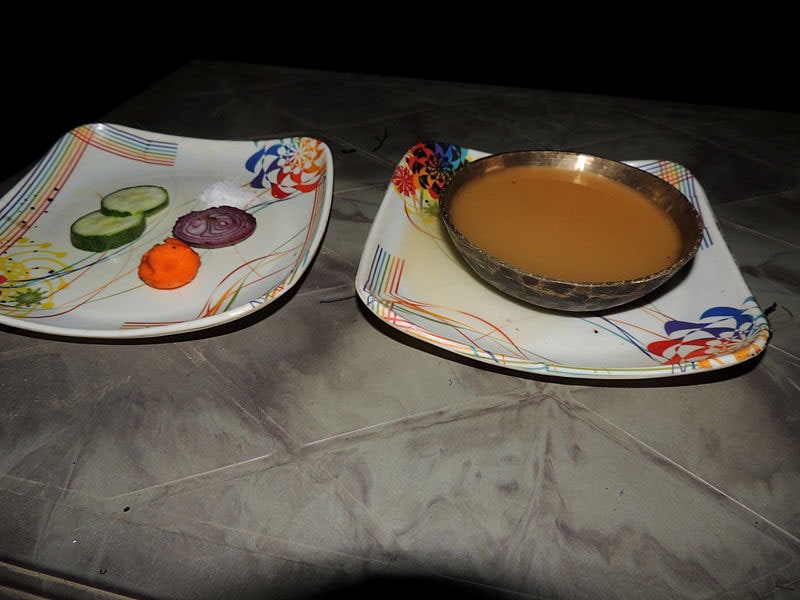
Apong, or Apo, is a traditional beer from northern India in the states of Arunachal Pradesh and Assam. This distinctive beverage is crafted through rice fermentation, giving it a characteristic murky brown color. The history of Apong dates back to the Neolithic period, commonly known as the Stone Age.
Apong is deeply ingrained in the cultural fabric of the region and is often featured in festivals such as Nyokum, as well as ancestor worship ceremonies celebrated by the tribes of Arunachal Pradesh. Usually, different tribes or communities within the region have their unique names for Apong.
Apong boasts a sweet flavor profile with a subtle hint of saltiness that adds a layer of complexity to the taste.
Where to find: In Northern regions of India, especially at small tribes and communities.
21. Toddy (Indian Palm Wine)
Alcoholic
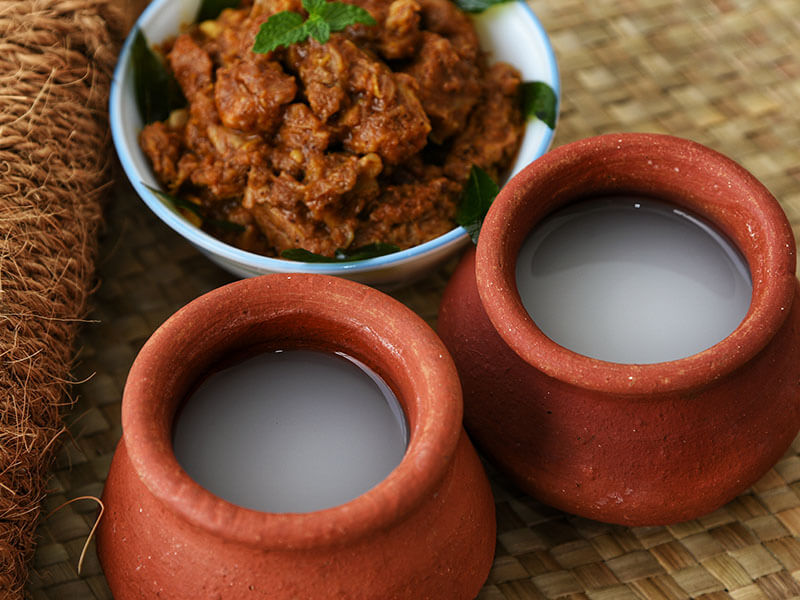
Toddy is a kind of palm/coconut wine that appeared in India thousands of years ago, originating from the Southern region of India. It’s the inspiration for the “Hot Toddy” – a famous alcoholic beverage created when India was under British colonization in the 1610s.
Some people say the term “Toddy” was derived from “taddy”, a word meaning “fermented palm sap’s drink”. The name of this drink is actually more varied than that in India. You might also find it as Tari in the Bengali language, Kallu in the Tamil language, and more.
The palm trees that can provide the ingredients for this alcoholic drink are coconut/dates palm or Palmyra. After collecting the sap, local producers will let it ferment within a day, and the outcome will be distilled to offer a more intense, wine-y base.
Indians usually consume the sap (Kallu) within the collecting day to avoid it becoming acidic with a very sour profile. Note that the Toddy alone is non-alcoholic before starting the fermentation process.
Where to find: At the toddy shops, smallholders, and individual farmers in India.
Health Benefit of Indian Beverages
Indian refreshments are known for their rich flavors and diverse ingredients, many of which offer a range of health benefits. Traditional Indian beverages often incorporate herbs, spices, and other natural elements to promote well-being and balance in the body.
Fermented Indian concoction is excellent for digestion. These fermented beverages contain probiotics, which aid in maintaining gut health, boosting the immune system, and reducing inflammation.
Another traditional option is Masala Chai, a spiced tea that features a blend of invigorating spices like ginger, cinnamon, cardamom, and cloves. Ginger and cinnamon are known for their anti-inflammatory properties, while cardamom and cloves can help with digestion and respiratory issues.
Or, Nimbu Pani (lemon water), is a simple yet beneficial Indian beverage. Rich in vitamin C, it supports the immune system and aids in digestion. Additionally, lemon water helps in detoxification and can contribute to maintaining a healthy weight.
FAQs
Explore the remaining facts about Indian refreshments through this small section of frequently asked questions. I hope this section can further help you become knowledgeable about Indian beverages.
These Most Suggested Drinks In India Are Worth Trying Once
Even if you haven’t tried them all, this list of India’s most recognized beverages is sure to astound you. Every recommendation on this list contains spices, and you may also find some soda or alcoholic drinks on it.
Indian refreshments or drinks, in general, are simple to consume and provide several medical benefits. As a result, if you have the opportunity, take all of my proposed solutions at least once before.
I’m confident you won’t be disappointed if you taste them. Don’t forget to come back to tell me what you think and share your experienced ideas with your loved ones if you are satisfied with them.
